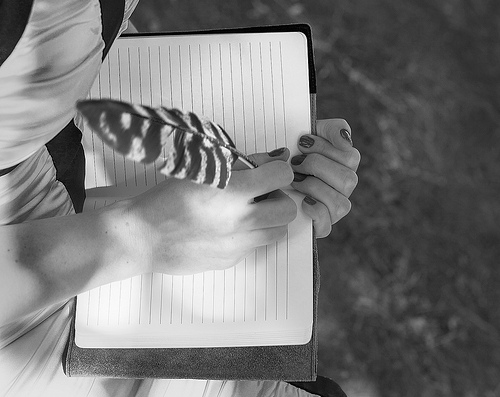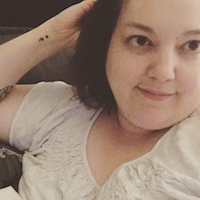I was on my way to work, February 20, 2014 when I pulled my car off of I-25 onto the median between the highway and exit ramp. I needed a moment to reconsider whether driving my car into a concrete pylon to kill myself was what I really wanted to do.
This was one of my many plans to commit suicide I’d come up with over the last several weeks and I finally had an opportunity to make it happen. I had just left a doctor’s office where my plea for help was blown off, thrusting me into a severe anxiety attack. My palms were sweaty, tears streamed down my face. The world around me was blurry through my tears. All I could see was hurt, despair, anger and hopelessness. My heart was racing. I cursed the doctor for ignoring my plea for help. F*ck that piece of sh*t, I thought. I sat on his table and told him my plans to kill myself and his response was to increase my slow-acting anti-depressant. Won’t he feel like an idiot when he finds out I was serious about killing myself?
I begged him to help me and he sent me on my way with nothing but more tears and another reason to feel alone and hopeless.
The air was choking me and I struggled to breathe. My grip on the steering wheel was getting tighter. No one would know it wasn’t an accident. I hadn’t told anyone except for my doctor that I was having these thoughts. Some people close to me may have known I was struggling with another bout of depression and anxiety, but I hadn’t told them how severe it was or that I was not just considering but had started planning my suicide.
There, on the shoulder of the highway, I sobbed heavily at the thought of killing myself. However, after the last couple months of pain and anguish, I had concluded that this was the only way to find relief. My family would be devastated. I was sorry for them but none of them could ever understand this pain. They could never understand how deeply into despair my mind had sunken. They could never understand how hopeless I felt about life, how completely broken I was inside. They would be okay. It would be hard, but time would heal them. I thought about my nieces and nephews and how I would miss seeing them grow up. But they would be okay too. I was at my darkest, blackest moment and the sweet release of suicide was the only thing that made sense. It was the only thing that would end the pain.
When I talk about the pain, I mean a mental anguish that can rarely be described to anyone who doesn’t suffer from mental illness. It’s natural to suffer from depression after a loss of a loved one, a relationship, a job, etc. Depression is a natural emotional state that everyone goes through at some point in their life. I don’t mean to dismiss that depression. I know it’s real and I know everyone feels it. However, for those of us who suffer with chronic major depression, the word has much deeper meaning and a much different impact in our lives. It’s a black cloud that’s with us all the time. Every day could be one of those depression and anxiety-ridden days. At any time I could slip quietly or tumultuously into the throes of a depressive episode.
For me, anxiety and depression go hand-in-hand. They feed on each other. When I’m depressed, I start having anxiety attacks. When I suffer anxiety attacks the downward spiral into depression is inevitable. The combination of the two leads me to that dark place. It’s a vicious endless cycle. I am constantly resetting my thought patterns, practicing self-care, and making sure I take my medication and pay attention to signs of anxiety attacks so that I can stop them early.
As I sat there contemplating whether I was truly ready to end my life, a small glimmer of hope appeared. There is a train station just a few blocks off the Broadway exit ramp. I could park my car, take the train into downtown and go to work. That would take the car out of my hands and give me a chance to get some help. I just needed to get out of my car.
I pulled into the train station parking lot, still contemplating going back to the highway. I should just get it over with. This pain is never going to end. I cried the entire train ride to work.
Why didn’t I just do it? I felt like such a coward for not following through when I had the opportunity. I spent nine days in the hospital after I asked for help that day.
As I suspected, family had no idea I was suffering so greatly. They had no idea that the last few months had been torturous for me or that I spent nights crying my eyes out because I couldn’t find any alternative to killing myself. I couldn’t admit that I was powerless to this disease. I couldn’t tell them that I was slipping deeper and deeper into an abyss of anguish. I couldn’t make them understand that suicide was the only rational end. I didn’t trust them to understand the depth of my pain.
I left the hospital with a hopeful feeling that I hadn’t felt in years. I was inspired and optimistic about the future. I didn’t quite know how to get better, but I was committed to being more proactive in my fight against this merciless disease.
Over the next 6 months, hours of talk therapy, making lots of mistakes and lots of changes, I realized that I had not been living an authentic life. I wasn’t being true to myself and honoring my feelings. I hadn’t been willing to admit that I was unhappy with my life, my relationships and myself. I didn’t love myself enough to demand respect from others. I stayed in a marriage I should have left years earlier. I don’t blame the failure of my marriage on my depression, nor my depression for an unhappy marriage. Letting go of that toxic relationship was both the saddest and most joyful moment of my life. I felt the weight of years of pain, anger, and sadness lifting off my shoulders. I was free from the weight of
someone else’s dependence on me. Thich Nhat Hanh said, “You must love in such a way that the person you love feels free.” I never felt that way in my marriage and so I had to set both of us free. This was the biggest step on my road to an authentic life.
I’ll always struggle with depression and anxiety. But the first line of defense is living an authentic life, being honest with myself and those around me about how I’m feeling, what I need and taking steps to keep myself out of the dark place. My physical and mental health and staying true to myself are my first priority.
If a relationship doesn’t serve me in a healthy way, I leave it behind.
If someone doesn’t respect my feelings, my heart and my overall wellbeing, I leave them behind.
If a situation doesn’t make me feel whole or takes away a part of my self-worth, I leave it behind.
Never again will someone else’s happiness come at the expense of my own.
I’m allowed to be frustrated with this disease. I’m allowed to cry when I’m upset. I’m allowed to vocalize that frustration.
I’m allowed to take a time-out to catch my breath when this disease takes it from me.
No longer will I be made to feel guilty for taking care of me and keeping this black cloud at bay.
The most important step I’ve taken to living an authentic life is to never stay silent about my mental health struggles. I’ve learned to trust those around me with my truth, to live my truth and own every piece of it, to surround myself with people who understand that this disease is part of my truth and to know that even though they may not understand the depth of my pain, that they are there to support me. Because when it comes to this disease, I am weak. I need the strength of my friends and family to hear my cries, to listen to me when I’m down and trust that I’ll always be honest with them about where I am mentally and emotionally.
Finally, leading an authentic life means doing things I love without apology. I keep my soul and spirit balanced through meditation, hiking, enjoying nature, good music, writing, laughter, love, practicing mindful behavior, forgiving myself for the mistakes I make and enjoying everything this beautiful life has to offer.
~
Author: Pamela East
Editor: Katarina Tavčar
Photo: Walt Stoneburner/Flickr

 Share on bsky
Share on bsky







Read 4 comments and reply